Continued from Part 2.1: Touring Israel – Aug 1986
Part 2.2: Jerusalem—Aug 1986
Thursday Evening
Back in Jerusalem by early evening, I rushed to the Hilton (today’s Crown Plaza) to meet my mother. She had flown in to Tel Aviv airport and had been transported to the hotel as part of her package tour. It was too late to do anything so we spent the evening in the hotel. Her room was in a top floor, so while it was still light outside we stood on the balcony to survey the area. She was eager to take a look at her hometown but the hotel was at the edge of modern-day Jerusalem so nothing looked familiar. In her days, this part of the city was probably not even developed.
We then went downstairs for dinner. After nearly a week of subsisting on falafel and shawarma, I was glad to be treated to a nice, juicy steak (those were still my carnivorous days). I’d had an exciting time full of fascinating experiences and adventures, and I couldn’t wait to tell Mum all about it.
In my immediate family—with the expected exception of my mother—we (my father, brother and myself) had an appreciation of Israel’s industriousness, competence and efficiency. Admittedly we often over-emphasised all that just to rile Mum (humour has always been our family’s saving grace) but to a large degree we did admire Israel. Although I was fully aware that Israel’s creation was the cause of my maternal family’s (and the rest of the Al-Fatah’s – see Part 2.1) dispossession, it was more of a dry intellectual fact which hadn’t sunk in emotionally—just yet—as the family stories didn’t overly dwell on the pain and hardship brought on by that dispossession. My Palestinian family had eventually landed on their feet and their subsequent reminisces revolved more around the richness and joyfulness of their Jerusalem lives before the Nakba, on the things they actually missed: the people they knew (family, friends, acquaintances), their schools and extracurricular activities, their outings and favourite places, their get-togethers and good times.
Now I’d had first-hand experience of this country. I had been particularly impressed by the way Israel had developed its resources. The landscape and climate are so similar to that of Cyprus, I couldn’t help but think (afflicted perhaps by a mild case of “familiarity breeds contempt”) that they were doing a far superior job than we were. My warm interactions with the locals added to my enthusiasm. I narrated all that to Mum over dinner and was eager to use the few words I’d picked up along the way, offering my yes’s, please’s and thank-you’s to the hotel staff in Hebrew. My mother, my intolerant, judgmental, over-dramatic mother who’d fly off the handle at the drop of a hat, said… nothing. She just grinned and listened. Calmly.
Friday Morning
The next morning, having by now become an expert on the city’s public transport, I made my way back to the Hilton, picked up Mum and put us on the bus to the Old City. As we sat facing each other, I could see how excited she was and anxious to identify familiar places. But at first it all looked foreign. Her eyes darted all around uneasily, scanning the images streaming past us, struggling to identify her surroundings. As we got nearer and nearer, I could see question marks forming on her face: Could that be…? Hm… maybe not… Doubt, uncertainty and a touch of disappointment at not being able to immediately recognise her city. But then, as we approached, I saw her face transform in an instant and her eyes well up. She knew exactly where she was.
We got off the bus at Jaffa Gate. Mum stood in front of the Old City walls hardly believing she was there after so many years. I’d expected her to be at least somewhat wistful. But no. She was simply overjoyed: she was home!
I asked her for a moment’s pause to get my bearings. Finding my hotel through the narrow winding streets had been a challenge in the past couple of days despite my good sense of orientation. But this woman wasn’t going to wait! Thirty-eight years had been long enough. She pushed ahead, calling out and gesturing at me to follow her: “Come with me! I’ll take you a different way!” So I scrambled after her as she navigated this maze of a place as if she’d only been gone for a week or so, and led me to my hotel, to my uncles’ old school and from there to every nook and cranny of the Old City.
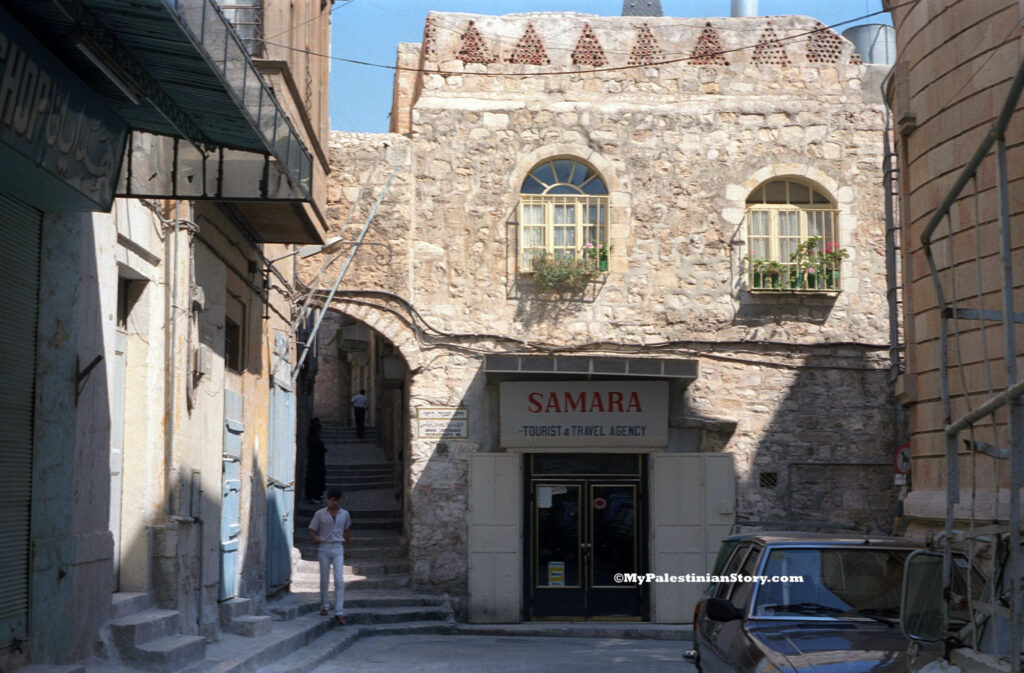
Then, all of a sudden, the stories started coming to life. Just before reaching the Greek Orthodox Patriarchate, outside a shop named N Zaphiriadis & Co Ltd, two ladies were chatting in the sunshine. In a nonchalant tone of voice, as if she was used to seeing them every day, Mum said: “Oh, there’s Ioanna and Marianna.” I couldn’t believe it: some of the Jerusalemite names that had featured in the family lore had just morphed into flesh and bone, and were standing before me!
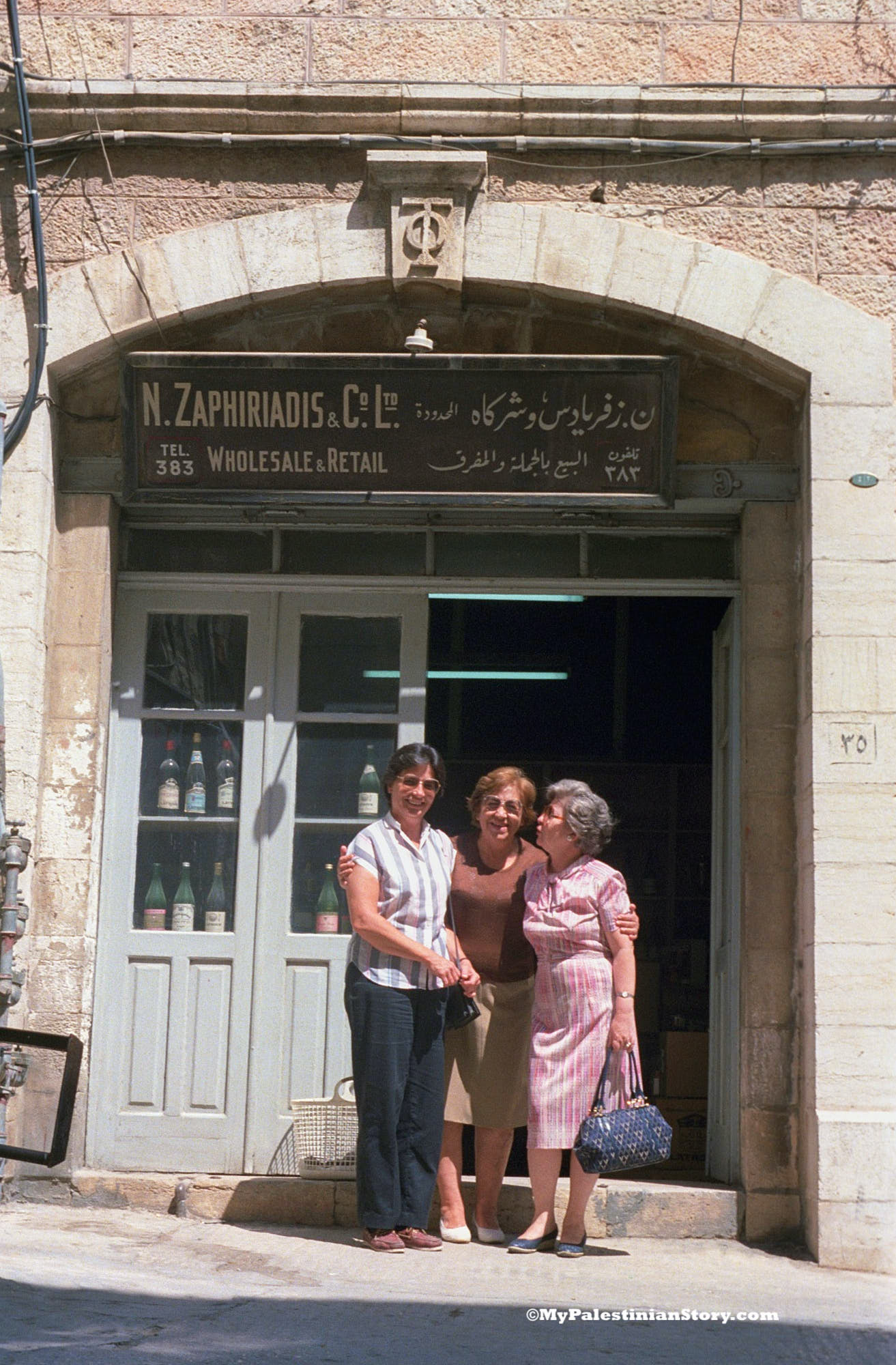
The ladies received my mother with enthusiastic surprise. The owner of the shop was Ioanna Ninou (née Zaphiriadis), the daughter of the original owner and a good friend of aunt Vasso, Mum’s eldest sister (as well as of Hala Sakakini1). The Zaphiriadis family lived in Katamon until 1948, in a house opposite the Claridge Hotel, not far from the Sakakinis. The father had owned a larger grocery as well as a restaurant on Mamilla Road before the war. The grocery had relocated and downsized inside the Old City where we now found it, managed by Ioanna.
Marianna Bannayan was born Spyridon. Her father, Spyros Spyridon, a Swiss-trained electrical engineer, was an active member of the Greek community of Jerusalem and one of the founders of the Greek Club. He was also the creator of the Jerusalem Panorama map. Marianna’s Swiss mother, Trudy, was also very active in the community, in charity work as well as in the Girl Guides where she was my mother’s beloved leader.
Marianna’s family had taken refuge in the old city in 1948 which put them on the Jordanian-occupied side after the armistice. Even though Marianna never left Jerusalem and still lives in the Old City to this day, in the eyes of the Israeli state she’s an “Absentee”. Which means she can drive past her home in Lower Baqa’a but has no rights to it.
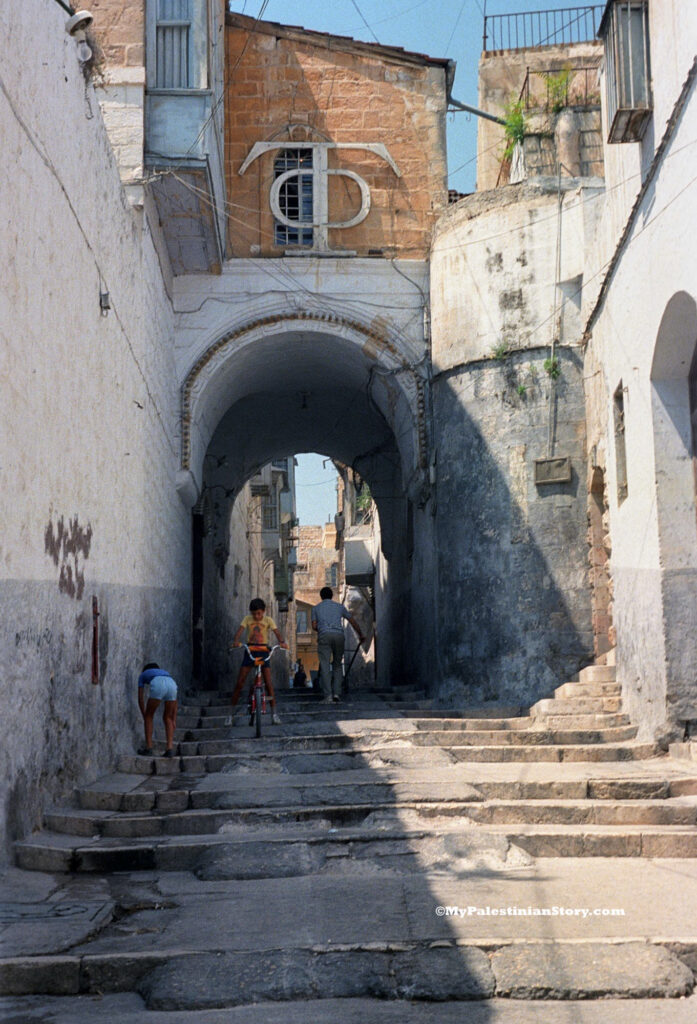
A few doors down we found ourselves outside the Greek Orthodox Patriarchate. Mum was visibly moved as we stood at the door. Her father, Manolis Kassotis, from the Greek island of Samos, was a nephew of Samian Patriarch Damianos I (1848-1931) who took his nephew under his wing and brought him to Jerusalem. Manolis was raised in the monastery and after a few years’ university studies in Athens, he was summoned back to Palestine (probably on account of the outbreak of the First World War) where he took on the lease of a huge estate that belonged to the Patriarchate, next to the village of Al-Breij, some 13km east of the city. He managed that estate (which in Greek they called Bretz—Μπρετς) until the Nakba.
We started up the large staircase which is surrounded by huge portraits of Patriarchs past. Half-way up, we stopped to search for Damianos, our “great-uncle”. As we lingered on the steps, an old monk shuffled up the stairs, stooped from age. On seeing us, he paused on the step below and squinted at us. Then, pointing a finger at my mother, he exclaimed, “You, you are a Kassotou!” I froze—completely dumbfounded! My mother was an 18-year-old girl when she left Jerusalem and was now a middle-aged woman of 56, nowhere near as svelte as she had been in her teens, and this man, whom she didn’t know, had somehow recognised her. To this day, whenever I think back to that incident, it gives me chills. There are still times when I ask myself if it happened for real or perhaps I dreamt it up…
In the monastery across the street, we visited Father Yermanos, an old priest, friend of the family’s, in his private quarters. From him we learnt that there was no point in attempting to look for Breij as the estate no longer existed. It had been taken over by the state and was broken up into separate pieces that had been developed in different ways. I was greatly disappointed. So many of the family stories were about their time in Breij but now I’d never be able to see the place in real life.
We continued to weave our way through the Christian quarter, visited the church of the Holy Sepulchre and eventually exited the Old City through Damascus Gate. Across the street, we found aunt Vasso’s old school, the Schmidt College for Girls.
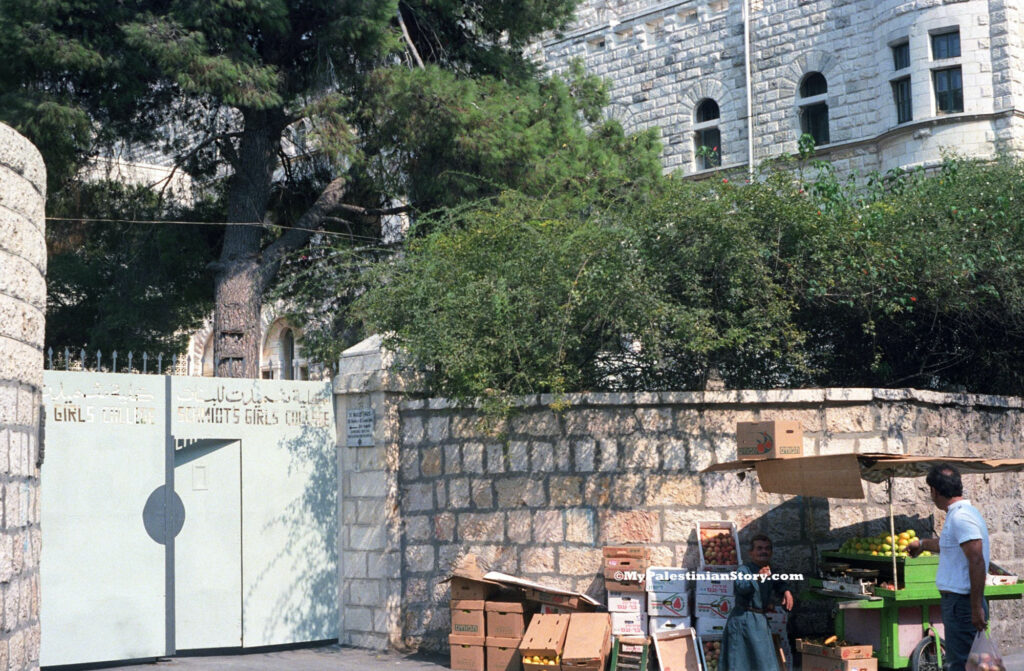
Friday Afternoon
It was time to go look for the house. But we faced a challenge: how to find it without an address? The street names were now all in Hebrew (I don’t think they had names back in my mother’s day). At least we knew the name of the neighbourhood remained (unofficially) the same: Katamon. We got into a taxi and started off with that. My mother had hoped that the Semiramis Hotel, two doors down from their house, would have been a useful reference point. Not so. The hotel, which had been bombed by the Haganah in January 1948, an event that precipitated the exodus from the neighbourhood, was never restored and disappeared down the black hole of memory.
However, in the course of the conversation, the Greek Consulate was mentioned. It is now housed in what until 1948 was the Egyptian Consulate and somehow my mother was aware of that. From there, Mum once again took over as navigator, directing the cabbie until we found ourselves outside the Semiramis—or whatever was left of it.
We got out of the taxi and took to the streets. There was hardly anyone around, neither pedestrian nor car traffic (the neighbourhood is very different today, busy and lively). We were standing on the storied katefóra, the downward slope that my mother and aunts always talked about when describing their gallivanting in the neighbourhood as children. They used to go down the katefóra to meet up with their cousins in Lower Katamon. Now we were headed the opposite direction, uphill.
The Semiramis was on the corner to our right. Right behind it, next up the hill, a two-storey building on the next corner, of what is now Ha-Shayarot street and the street we were on. And on the opposite corner of Ha-Shayarot, the house. My mother’s house. Our house!
A metal gate on the corner led to the front steps. Metal shutters covered the windows of the one-storey stone house with the red-tiled roof. Mum thought it looked just the same. But she wasn’t ready to go inside yet. We walked past it, looked at it from the side and the back. Then we stood outside the larger building behind it where some close family friends used to live, the Philalithes and Mavromichalis. Memories flooded Mum’s eyes.
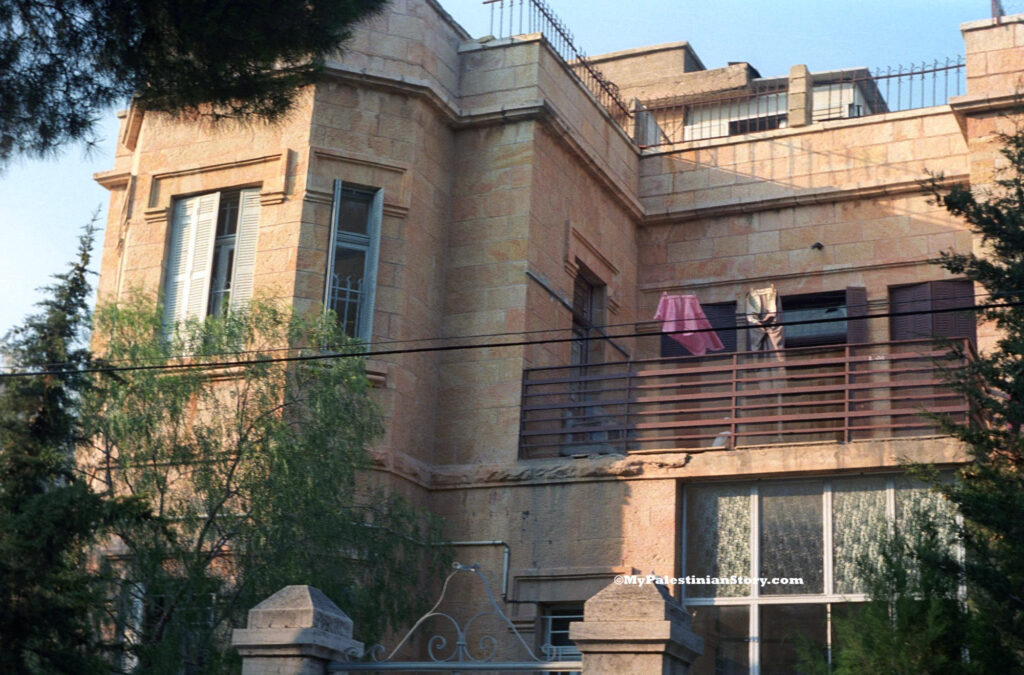
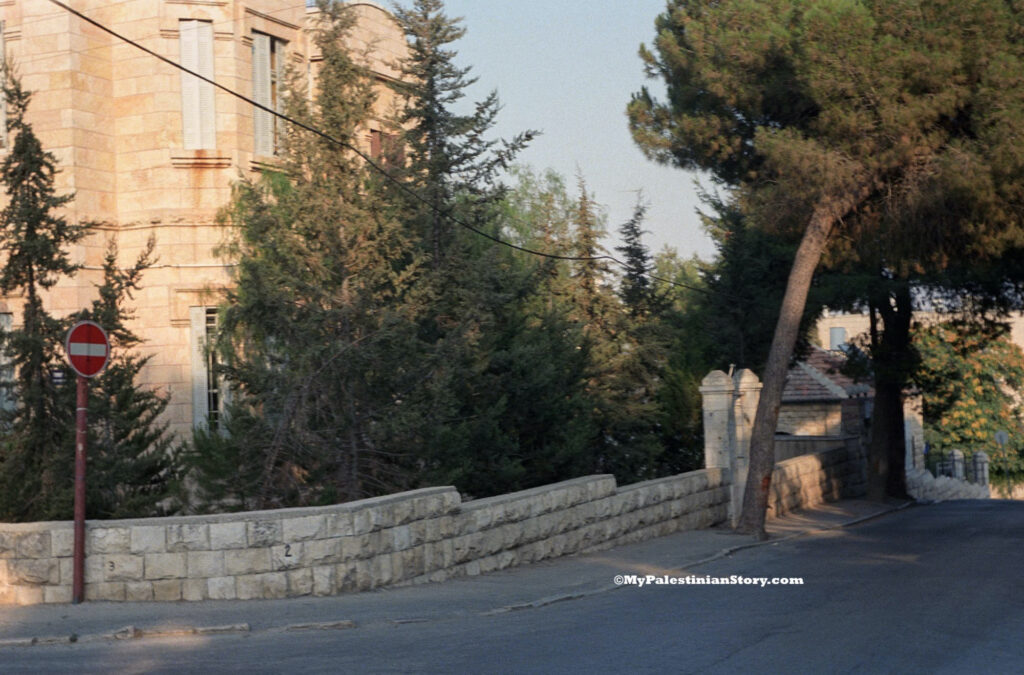
Katamon, Aug 1986
We took the few steps back to the house and knocked on the door. It was answered by a short man with a moustache whose English was in the range of minimal. Somehow an understanding was arrived at that it was ok to look at the garden but not inside the house. Very disappointing but there was little we could do. We walked around the small yard. There was basil growing in one of the planters which moved Mum tremendously as her father, Papou Manolis, used to grow basil, too. The owner allowed us to cut some. There was nothing else to do, so we headed out of the gate. He stood in front of it, pointed at the house with his finger and then pounded his chest with his flat palm. “This, this! Mine! Mine!” It was clear that he knew who we were. With a budding emotion stirring inside me, I was tempted to respond, “Actually it’s ours!” but quickly recognised the futility of that action. We walked away, my mum with a bunch of basil in her hand, grown by a stranger in her own garden.



Barely two blocks away from the house lies the Greek Orthodox church of St Simeon and its monastery (from which Katamon gets its name). We crossed the adjacent green with its tall trees and entered the church. In striking up a conversation with the priest, we discovered that he was from Limassol, Cyprus. He told us that things were difficult in Katamon. There were many orthodox Jews living there who were openly antagonistic towards non-Jews. Often kids would come and throw stones at the church, he said.
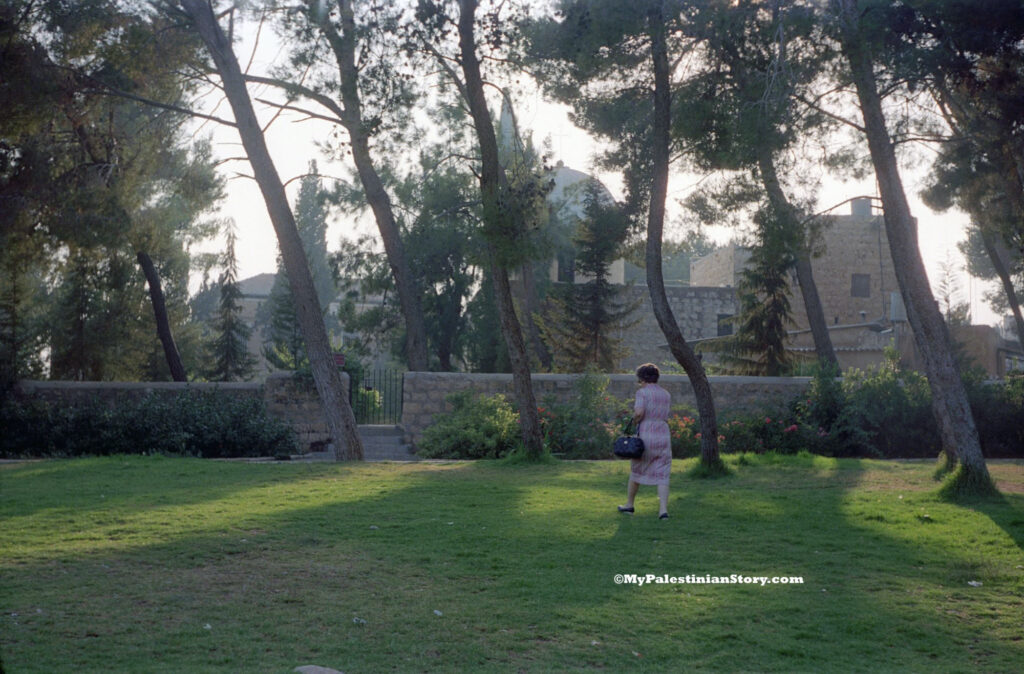
Despite the sad picture he painted, our meeting with the Cypriot priest made us feel good. There was a sense of things having come full circle. Mum and her family fled to Cyprus and when she returned, decades later, with her Cypriot daughter, she found a Cypriot priest in her church.
As we walked away from the church, our reverie was rudely interrupted by a man who appeared as if out of nowhere, possibly the first person we encountered in the streets of this awfully quiet neighbourhood. He was dressed in orthodox garb, complete with black hat and hair locks, and marched up to me, gesticulated threateningly at my camera, and spoke in an agitated tone of voice, presumably in Hebrew. I could tell he was not happy about me taking pictures.
Slightly shaken we moved on, down the katefóra, towards the house where Efthymios and Marika Gaitanopoulos used to live with their daughters, Mum’s cousins. As we walked along, Mum narrated matter-of-factly their life in Jerusalem and what their last days had been like. How their Arab neighbours had fled in fear as Jewish attacks increased, leaving families like my mother’s isolated. Soon after the deadly Semiramis explosion, the Kassotis moved in with the Gaitanopoulos whose house in Lower Katamon was inside the security zone. Eventually they all had to flee. They thought they were leaving for a short while, until the hostilities subsided. Little did they know at the time they’d never be allowed to return. And that it would take almost four decades before my mother could lay eyes on her home again.
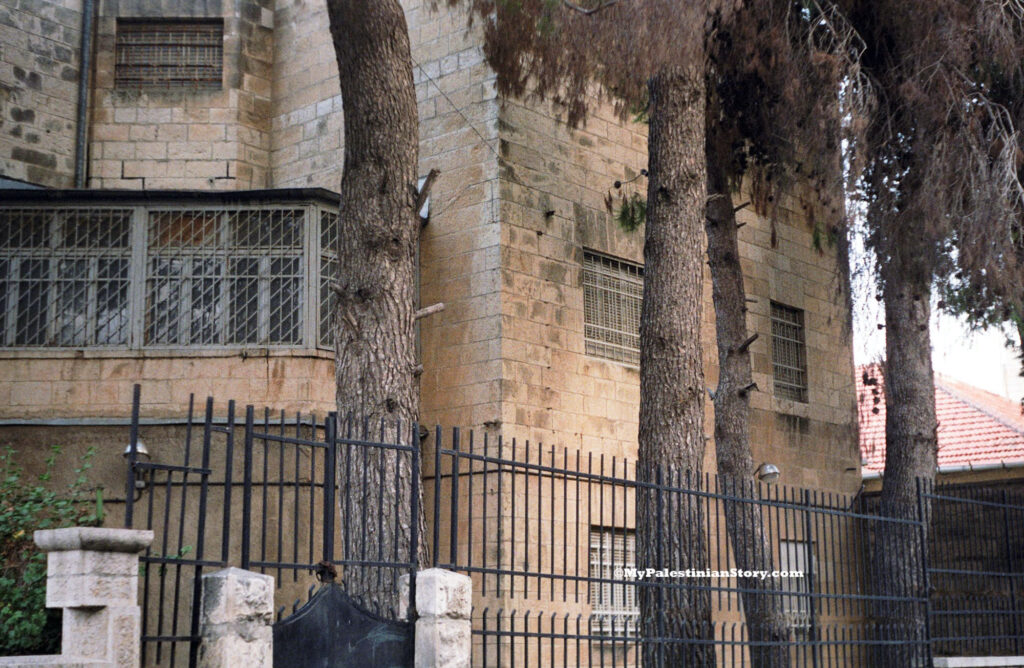
The Kassotis took refuge here after the bombing of the Semiramis in Jan 1948.
Katamon, Jerusalem – Aug 1986
This walk down the katefóra, along the streets of Katamon, with my mother’s uncharacteristically dispassionate narration, shook me up intensely. It became my road to Damascus. Her family’s dispossession was no longer a cold fact that could be the subject of jokes, however good-natured. Having lived through my own country’s division in 1974, with everything all that entailed (war, bombings, lost homes, dead, missing and displaced people in tent cities, barricades, divided and abandoned cities and a no-man’s land), I began forging a strong emotional connection to my Palestinian story.
Saturday Morning
The next day, my native guide, aka my mother, gave me a tour of the holy places. We walked along Via Dolorosa, exited from Lion’s Gate and climbed up the Mount of Olives from where we glanced back at the city within and around the walls, with its jumble of sacred buildings: the Dome of the Rock with its imposing golden dome; the Al-Aqsa mosque with the much smaller slate dome; further in the distance the Church of the Dormition; closer to us the golden onion domes of the Russian St Mary Magdalene Church, and so on. We visited the church of Pater Noster and then resumed our trip down my mother’s memory lane in more secular neighbourhoods.
Close to Mamilla, she was thrilled to see again the venue of many of her youthful activities: the YMCA with its trademark tower. Directly opposite, the King David Hotel looks grander than ever. It’d be hard to imagine from a distance the damage it had suffered in July 1946, when the wing that housed the British Mandate secretariat was blown up by Jewish terrorists resulting in 90+ deaths and many injuries—a milestone in the history of the “troubles” which I’d heard about at least a hundred times. But up close, a plaque on the hotel’s exterior wall actually commemorates the event (no regrets offered).
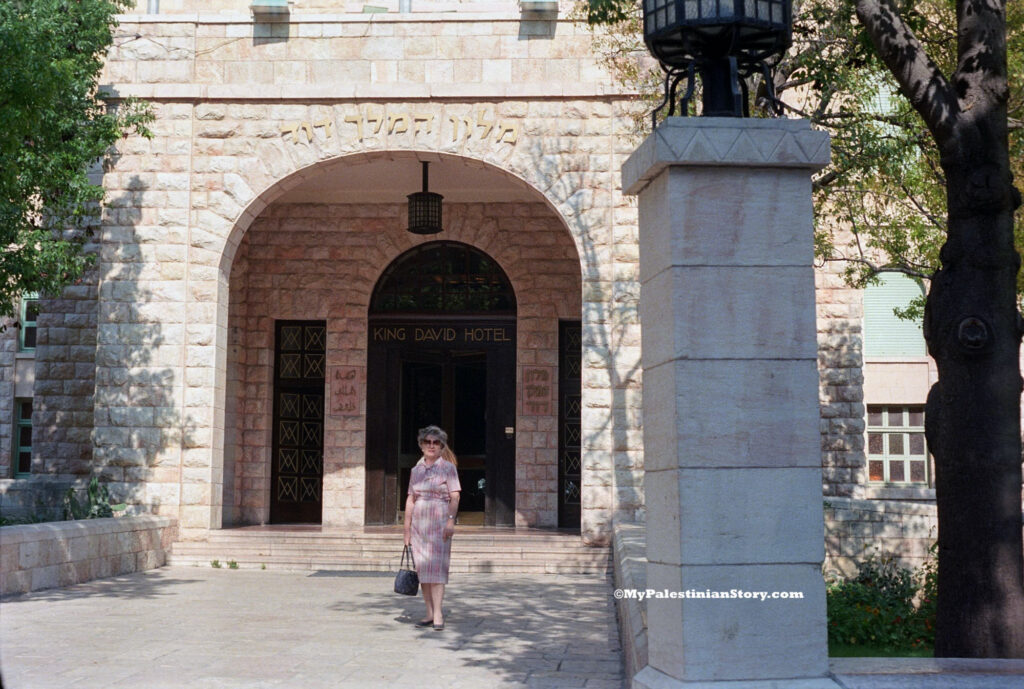
Saturday Afternoon
Perhaps it was the ladies we met the previous day who told us that familiar faces could still be found in West Jerusalem. Stratis Gaitanopoulos was an uncle of the cousins Mum’s family stayed with before leaving (Efthymios’s brother). He still lived with his wife, Aliki, in the house his father had built in Upper Baqa’a about a century ago. He studied music in Athens and had been a piano teacher in Jerusalem back in the day. He had also taught his own son, Mamelo Gaitanopoulos, a musician well known in today’s Israeli jazz scene.
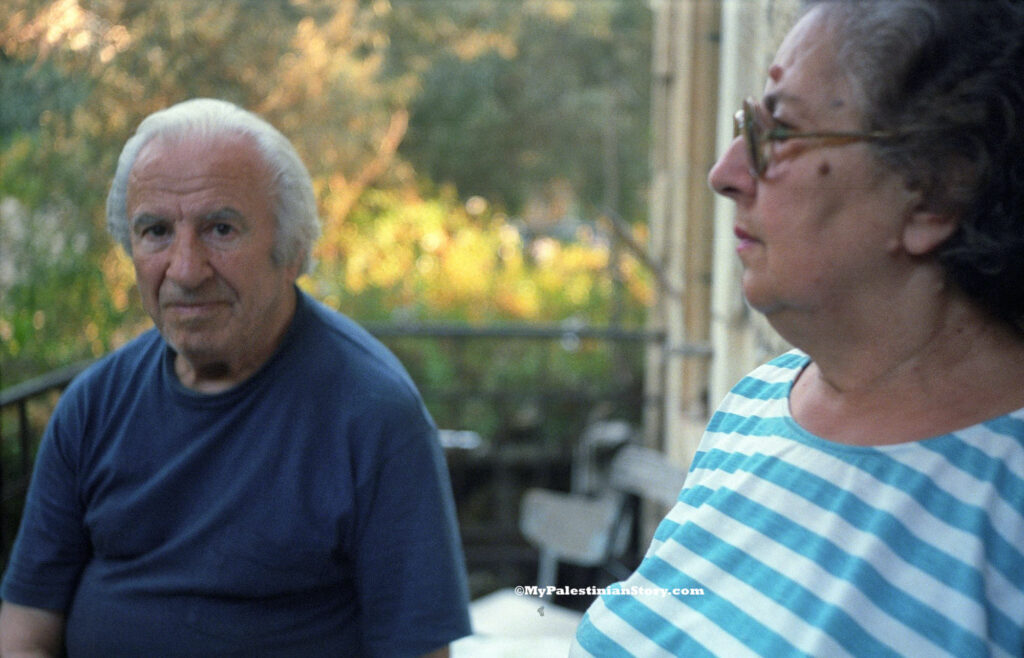
In a house across the street from theirs was where the Louisidis family used to live. They’ve been friends of the family since those days—in fact my oldest friend is of that family. We took photos to show to our friends and then looked in on the Gaitanopoulos.
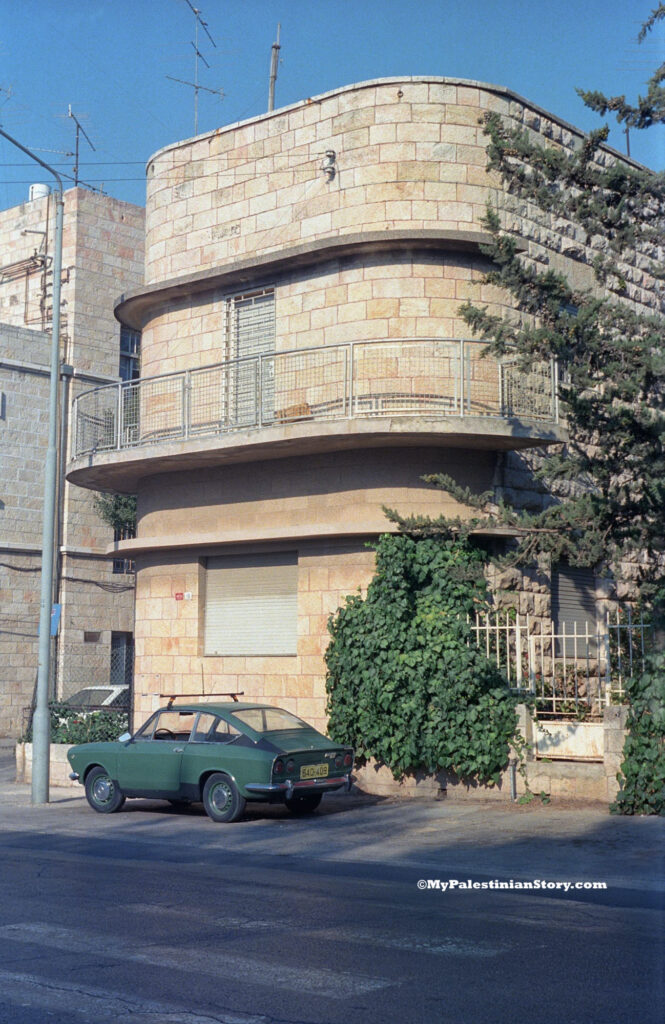
We found Uncle Stratis and Aunt Aliki sitting on their balcony. They were thrilled to see us. After exchanging news with my mother, Aliki took us for a wander on foot through the neighbourhood, all the way to the Greek Colony. We ended up at the Greek Club, a place which held so many memories for my mother. This was the gathering place for the Greek community—one of the largest ex-pat communities during the British Mandate—where they celebrated their religious and national holidays, where they ate, sang, danced and laughed together. It was established in 1902 and is still in operation today.
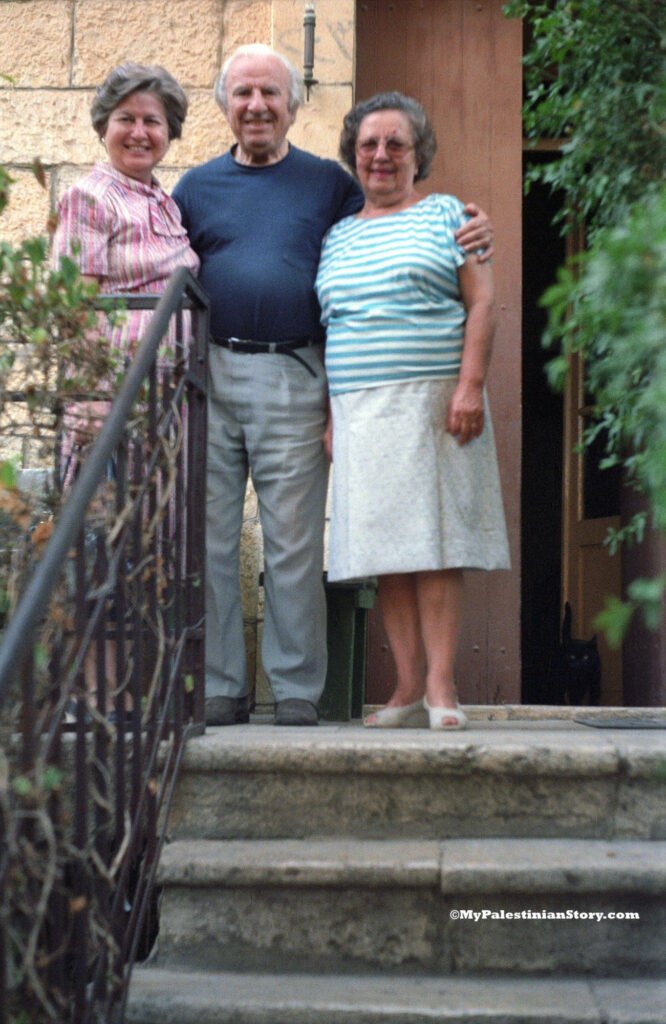
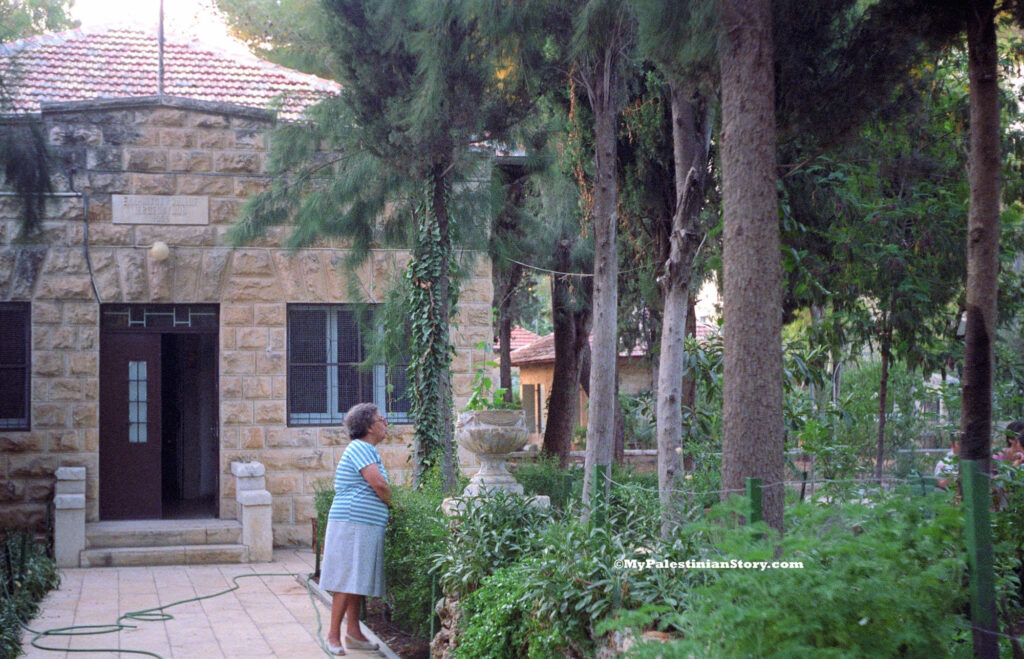
There was hardly anyone around: just a few of people hanging out in the garden. The club house was locked but Aliki had the key and opened up for us. The quiet emptiness was quickly filled with the scenes I had in my head: my aunts were dancing in the courtyard, just as they did in Uncle Nando’s film clip (see below), and my grandmother, Yiayia Vitsa, was on the piano while her youngest brother, Uncle Colia, was playing the accordion, and everyone was singing…
Sunday
Sunday was our last day in Jerusalem. Both Mum and I were leaving in the afternoon so we played regular tourists in the morning. We visited Yad Vashem (the Holocaust museum), the Suq, and the Wailing Wall. And then we parted ways. I left Mum at the Hilton from where she would be picked up and taken back to Tel Aviv airport, and I jumped on the bus to Haifa.
I sat next to a handsome young conscript; we hit it off immediately and chatted practically non-stop all the way to Haifa port. I told him about my escapades backpacking through Israel (but not about meeting my mother in Jerusalem nor our connection to the city) and I drilled him about life in the military service of Israel.
At the port he, in his military uniform, breezed through Security. I, on the other hand, like all foreigners, was put through the wringer and had to answer a zillion questions: “What is the purpose of your visit? Tourism. Where did you go? Show us your route!”(Had to pull out the map and show.) “Where did you stay, how did you know to go there, show us the page in Let’s Go that lists the B&B. Did you meet anyone?” “No, just people I befriended along the way…” I figured it would be too complicated to tell them about my mother. Plus I was afraid that my newly found resentment would seep through. “No, I was on my own.”
My new friend was waiting for me and was growing impatient. Finally, they let me through. As I rejoined him, the look on his face was both incredulous and suspicious; his eyes bored into mine, striving to decipher my true identity which must have been the cause of my being subjected to such lengthy questioning. “Who are you?!?” he exclaimed. I laughed: “I’m nobody…”
And yet: I’m a Jerusalemite’s daughter. ❖
1 Ioanna is mentioned in Hala Sakakini’s memoir, Jerusalem and I: A Personal Record as Jeanne Zaphiriades.

Great writing and great photography. Someone should hire you out as a travel writer, Marina. When I saw that picture of Kyrenia, I got quite sentimental about our 2006 trip there, with the harbor and the ancient Venetian castle so beautifully illuminated. Cheers, Frank
Thanks very much, Frank. Really appreciated!
It is wonderful writing Marina, and your descriptions are such a balance of facts and emotion-evoking memories. The only thing that I (of course) would have like to know more about was in that last bit about your “newly found resentment.” I hadn’t gotten a suggestion of it in the previous paragraphs and it was so close to the end that I suppose there wasn’t enough space to elaborate as you rode off into the sunset with the dashing (in my imagination) Israeli soldier. Now . . . I’d like to know more about that!
Many thanks, Patricia. The resentment I mention at the end stems from the emotional connection I made as I toured Katamon with my mother. That’s when I really understood for the first time what losing their home meant for her and her family.
Thanks for posting these stories Marina. We really appreciate seeing all this history connected to our grandparents Marika Gaitonopoulos and family and her husband Bill Thorogood. Marika
Thank you for reading. I very much appreciate it!
I visited Aliki in 1997 after Stratis had died when I travelled there for work. She was very old and she’d prepared a Greek rice pudding with cinnamon for me. Likewise, I didn’t tell the Israeli customs nor even the Israeli cultural embassy staff, who’d invited me to Israel, about my links or my visit to the house, even though they were suspicious of me going off walking around Jerusalem on my own!
As if we are some danger…
You’re so lucky that you got to see the house as it was, before all the new building work! X
I am Greek from Jerusalem (old city) living in SF(Millbrae). I came to know about your work through my friends Ari & Marthoula Nicolaides. I would like to get acquainted.
My email: zbatarseh @hotmail.com
Zoe.
Many thanks for writing, Zoe. I’ll email you directly.
Hi Marina
I finally got to Jerusalem and to the old house, where Mamelo was very generous and cooked us dinner, found us a good Greek doctor for my daughter when she became unwell on the sabat, and drove us to the airport.
It was moving to read about your mother in this blog., especially as I now know most of the places you’ve mentioned.
We must have a catch up chat soon!
Cathie
Would love to hear all about it in person!
This is very interesting. My grandparents lived in Netanya then kicked out to the wet bank and eventuallly kicked out into the dessert. So many still have keys to their homes, would love to hear how your mom feels about the situation, her home and community
Thanks for reading, Lana. My mother died in 2016. Her Greek identity was very strong in her but she also felt very strongly that she was Palestinian. She was born and raised in Jerusalem and so was her mother and her mother’s father. That was home. Although the Greek community felt they were in between the fighting Arabs and Jews, their sympathies were most definitely with the Arabs amongst which they lived and with whom they socialised.